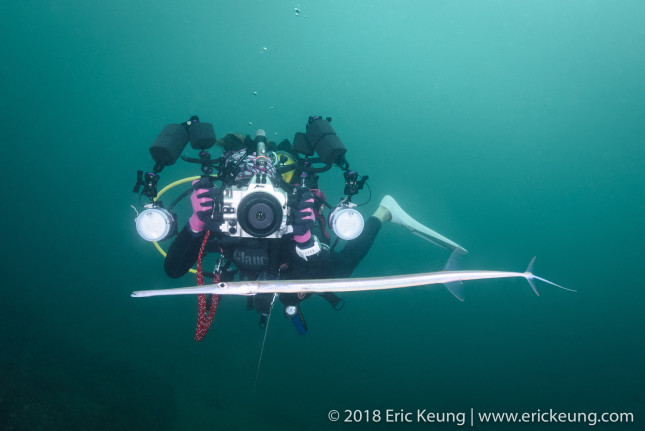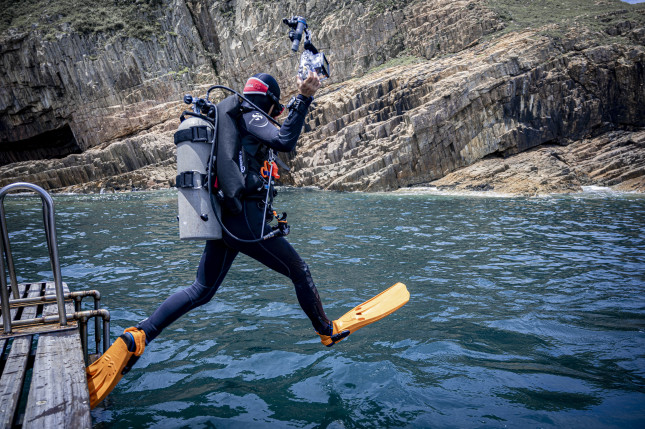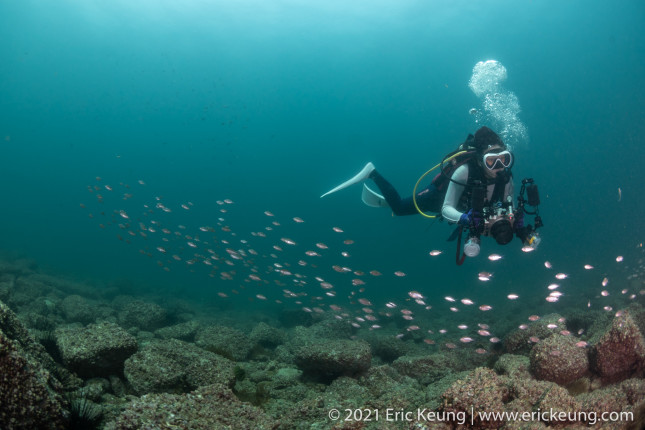-
Seeing Beyond Seafood: The 114°E Hong Kong Reef Fish Survey
June 8, 2023 By Stan SheaDazzling skyscrapers, kung-fu movies, and live seafood restaurants are what people think of when they contemplate small and densely populated Hong Kong. So, it is a shame that we rarely talk about Hong Kong’s “wilder” side—such as the approximately 40 percent of our land area that is designated as country parks, or the more than 200 offshore islands that include sites of the Hong Kong UNESCO Global Geopark.
Indeed, when we talk about fish in Hong Kong, most people immediately think of seafood. The iconic live fish tanks at the city’s wet markets and seafood restaurants are filled with reef fish imported from around the world. That is no surprise: Hong Kong is the second highest per capita consumer of seafood in Asia.
Yet few people (even the locals) are aware of the incredible underwater diversity, happening just beneath the waves of Hong Kong waters. Hong Kong comprises only 0.05 percent of the marine territory of the South China Sea, yet it boasts more than 30 percent of the area’s marine fish fauna, of which more than 400 are reef fishes. Such diversity has been described as comparable to the tropical Caribbean.
Born and raised in Hong Kong, I have witnessed the complicated relationship that Hong Kongers have with the ocean, and how that relationship has evolved. Historically, many livelihoods in the city relied on the sea and its marine resources, so it felt very strange to see that most of our fisheries had collapsed several decades ago without Hong Kongers even realizing it.
A lack of awareness and direct contact between the local people and our ocean seemed to be one of the root causes of this collapse, and a large obstacle to efforts to protect ocean biodiversity. So, I started the 114°E Hong Kong Reef Fish Survey (114°E Survey for short, representing the longitudinal coordinates marking the eastern territories of Hong Kong waters) with one of my old University of Hong Kong classmates to obtain a better understanding of the kinds of reef fish in our waters, and then disseminate this new knowledge widely.
The citizen science component of the 114°E Survey is a key element of the study. With the support of BLOOM Association Hong Kong (BLOOM HK)— where I work as the Marine Programme Director— we are creating a new way to build awareness of the incredible fish species that live beneath the waves and encourage advocacy for ocean protection.
Finding Fantastic Fishes in the City
Citizen science is at the heart of the 114°E Survey, and we recruit recreational divers as volunteer surveyors for the project. Despite Hong Kong’s low general awareness for marine matters, the city has a well-established community of scuba divers—and many excellent underwater photographers. We hoped that engaging citizen scientists would allow us to more effectively reach out and connect with the local people to educate them about the local marine life and the related conservation issues.
The goal we set out in July 2014 was simply to see what we would find, and we were blown away by what we saw. Even though most of our survey team have been diving in Hong Kong for many years, it wasn’t until we had the survey and recorded our observations in the data that we realized just how diverse Hong Kong’s reef fish were.
Hong Kong does not have true coral “reefs,” but rich “coral communities” can be found at many dive sites. One of these sites—Sharp Island—is just ten minutes away from the Sai Kung public pier, and it was one of our survey’s most visited dive sites. Diving near this robust coral community, you can easily encounter a variety of butterfly fishes, groupers, damselfishes and snappers. Those with a keen eye can easily spot more cryptic or camouflaged fish, such as colorful gobies and frogfishes. It is not uncommon to count up to 50 species here in a day of diving.
Traveling a little further away from the city, there are dive sites where citizen scientists encountered beautiful schools of tunas and amberjacks. Some of my own favorite encounters have been with the round ribbontail ray (Taeniurops meyeni), which is known to grow to more than three meters long. More than once, we come across individual fish in this species that were the size of a dining table, sometimes with live sharksuckers (Echeneis naucrates) attached to them.
These encounters remind us of what the marine life in Hong Kong waters used to be like—and what it could return to in the future. I remember flipping through some old fisheries journals and coming across a black and white photograph from the 1950s of a manta swimming around Basalt Island. Our 114°E Survey findings remind us that there is still hope to restore some of what we’ve lost. At the very least, we can protect what we still have – which is quite a lot.
Since 2014, we have documented more than 400 species of reef fishes in Hong Kong waters, including 50 that are new in Hong Kong’s official records. We also launched the 114°E Web-Portal in 2019 to showcase our findings, and to help bring the story of Hong Kong’s reef fishes out from beneath the waves and present it to the eyes and minds of the public.

Support for a New Vision
Through the Convention on Biological Diversity (CBD), Hong Kong has committed to have at least 30 percent of its territorial waters designated as Marine Protected Areas (MPAs) by the year 2030—known as the “30 by 30” initiative. By continuing the 114°E Survey, we hope the project’s data can inform plans for new MPAs that will take sites important for reef fish biodiversity into consideration.
Over the next three years, the Pew Marine Fellowship will support this work, enabling our dataset to reach a decade of data by 2025. It will also allow us to create the first in-depth analysis of the whole ten-year dataset to provide an up-to-date picture of Hong Kong’s reef fish diversity, distribution and qualitative abundance for the first time in many years. These results will provide insights on several topics, including threatened or commercially important species in Hong Kong, the location of key fish biodiversity hotspots, and changes our reef fishes over the past decade.
The support from the Fellowship will also allow additional outreach work, including to the local diving community, schools, decision-makers and members of the general public—including the dissemination of a forthcoming guidebook featuring all the species found in the 114°E Survey.
Despite our love for seafood, few people in Hong Kong realize that 90 percent of the seafood we now consume are imported. Many local stocks have long been depleted, and the live seafood tanks provide only the illusion that our waters can still support our consumption. We hope our work allows more people in Hong Kong to learn about our reef fishes and learn to value them as an integral part of the marine biodiversity.
Citizen science and outreach efforts like the 114°E Survey can help redefine the concept of “fish” in Hong Kong. It may also spur Hong Kongers to see what is beneath these waters not only as seafood to be eaten, but a local biodiversity worthwhile of our appreciation and conservation.
Stan Shea is the Marine Programme Director at BLOOM Association Hong Kong and ADM Capital Foundation, and a co-founder of the 114°E Hong Kong Reef Fish Survey.
Thanks to our many supporters over the years, including: ADM Capital Foundation, National Geographic Society, Pew Marine Fellows, RS Group, the Swire Group Charitable Trust and other anonymous funders. The biggest thank you to the team at BLOOM HK and our community of 114°E Survey volunteers, who have truly become the ambassadors and a strong voice for Hong Kong’s reef fish.
Sources: Arthur Chung et al., FAO, Hong Kong Fish Net, Marine Biodiversity Records, Porcupine!, 114E HK Reef Fish
Lead photo credit: Eric Keung@114°E Hong Kong Reef Fish Survey, used with permission courtesy of Stan Shea/BLOOM HK
Second photo credit: Sam Inglis@114°E Hong Kong Reef Fish Survey, used with permission courtesy of Stan Shea/BLOOM HK
Third photo credit: Eric Keung@114°E Hong Kong Reef Fish Survey, used with permission courtesy of Stan Shea/BLOOM HK
Topics: China Environment Forum
 A Publication of the Stimson Center.
A Publication of the Stimson Center.










